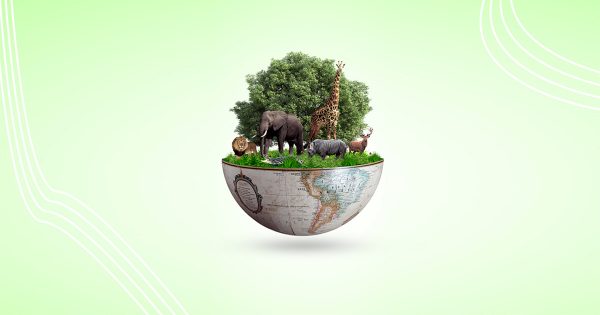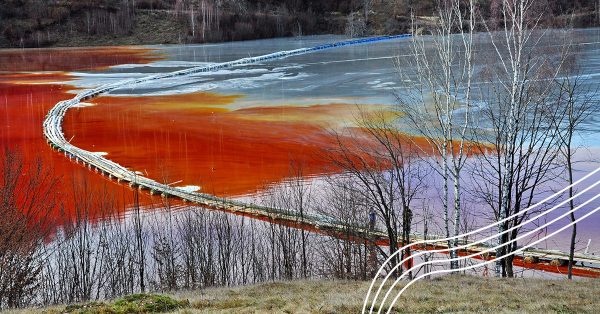Porphyry deposits are naturally occurring geological formations that are the largest reservoirs of copper and gold. New scientific developments in geology may drive gold mining prospects, as knowledge of the amount of gold in porphyry copper-gold deposits is important for mining operators to gauge the mine’s economic attractiveness and evaluate the distribution of gold in the upper crust of the Earth.
Formed by hydrothermal fluids underneath volcanoes that originate from an accumulation of magma, porphyry deposits are orebodies that can be exploited by open-pit mining. 1 These deposits, found mainly around the Pacific Ring of Fire, produce three-quarters of copper and a quarter of the gold mined over the world. 2 The questions that many mining operators ask have always been these — “Is a copper-rich porphyry deposit automatically rich in gold as well?”, and “How can we tell where the largest deposits are located?” 3
Scientific research has now uncovered certain peculiarities of porphyry copper and gold deposits, providing possible explanations into the different ways that they are formed. 4 In a recent study, scientists have discovered previously unrecognised structural lines going deep down in the earth that appear to signal the locations of giant deposits of metals, and the discovery could dramatically narrow down search areas. 5 This would inevitably reduce the footprint of future mines, as deposits can be mined economically and excavated material can be taken out via less disruptive shafts instead of open-pit operations. 6
Telescoping and overprinting of porphyry systems have also given rise to a greater understanding of likely surface expressions, in particular the significance of advanced argillic lithocaps in porphyry exploration. 7 Certain oceanic crust environments, such as those in Indonesia, the Philippines, and Papua New Guinea, are known to hold exploitable copper-gold porphyry deposits. 8 In particular, the Southwest Pacific region has at least four porphyry copper-gold deposits, with a significant amount of gold produced at these sites. 9
In early 2020, a University of Geneva researcher published a paper on how metals are accumulated over the time duration of a mineralising event, analysing for the correlation between amounts of copper and gold extracted from deposits. Results from the investigation indicate that two types of porphyry deposits exist; one, which is very deep, stimulates the mineralisation of copper over a long period, while the other, which is closer to the surface, precipitates more gold. 10 This is a valuable indication for the extractive industry, which can use these results as a prediction of depths to find large deposits of copper and gold. 11
As gold mining prospects increase over time with new scientific developments in geology, global mining corporations are recognising the need for gold mining to be conducted safely, sustainably, and ethically. Clean Earth Technologies has a non-toxic gold recovery reagent for mining operators to mine cleanly and sustainably. In a recent metallurgical test of ore, gold recovery rates averaged 80-85% and the bulk of recovery occurred within the first four hours. Scalable to suit mining operations and ore types, Clean Earth Technologies’ mercury-free and cyanide-free alternative will also enable mining operators to raise their operational standards as its clean solution is suitable for greenfield mine locations as well as existing mining projects where cyanide is no longer preferred or banned.
____________________________
[1] For more academic literature on relatable ore systems (iron oxide copper-gold (IOCG) deposits) and their geological diversity, see, Patrick J. Williams et al., “Iron Oxide Copper-Gold Deposits: Geology, Space-Time Distribution, and Possible Modes of Origin,” Economic Geology, 2005, pp. 371-405, https://doi.org/10.5382/av100.13.
[2] Solomon, “Subduction, Arc Reversal, and the Origin of Porphyry Copper-Gold Deposits in Island Arcs,” Geology 18, no. 7 (July 1990): p. 630, https://doi.org/10.1130/0091-7613(1990)018<0630:sarato>2.3.co;2.
[3] Stephen E Kesler, Stephen L Chryssoulis, and Grigore Simon, “Gold in Porphyry Copper Deposits: Its Abundance and Fate,” Ore Geology Reviews 21, no. 1-2 (October 2002): pp. 103-124, https://doi.org/10.1016/s0169-1368(02)00084-7.
[4] For more on the characteristics of porphyry copper-gold deposits, see, R. H. Sillitoe, “Characteristics and Controls of the Largest Porphyry Copper‐Gold and Epithermal Gold Deposits in the Circum‐Pacific Region,” Australian Journal of Earth Sciences 44, no. 3 (May 9, 1997): pp. 373-388, https://doi.org/10.1080/08120099708728318.
[5] Mark Hoggard et al., “Global Distribution of Sediment-Hosted Metals Controlled by Craton Edge Stability,” Nature Geoscience 13 (June 29, 2020): pp. 504-510, https://doi.org/10.31223/osf.io/2kjvc.
[6] In this study, which started in 2016, Australian geologists found that the richest Australian mines lay neatly along a line where thick, old lithosphere grades out to 170 kilometres as it approaches the coast. Results from the study have been mapped out across the various continents, leaving researchers to believe that a 170-kilometre boundary seems to be the Goldilocks zone for creating the right temperature conditions for the precipitation of metal-rich deposits. For more, see, “Geologists Identify Deep-Earth Structures That May Signal Hidden Metal Lodes,” Phys.org (Earth Institute at Columbia University , June 30, 2020), https://phys.org/news/2020-06-geologists-deep-earth-hidden-metal-lodes.html?fbclid=IwAR3T34L9fAy_XH4NH7pHNEOjnxvpwqFaUMxy9FMYxKy8uq3hrPMqY0shho0.
[7] Mark P. Simpson, Jeffrey L. Mauk, and Ross G. Kendrick, “Telescoped Porphyry‐Style and Epithermal Veins and Alteration at the Central Maratoto Valley Prospect, Hauraki Goldfield, New Zealand,” New Zealand Journal of Geology and Geophysics 47, no. 1 (2004): pp. 39-56, https://doi.org/10.1080/00288306.2004.9515036.
[8] Stephen E. Kesler, “Copper, Molybdenum and Gold Abundances in Porphyry Copper Deposits,” Economic Geology 68, no. 1 (January 1973): pp. 106-112, https://doi.org/10.2113/gsecongeo.68.1.106.
[9] Andrew, R. L. “Porphyry copper-gold deposits of the southwest Pacific.” Min. Eng.(Colorado) 47, no. 1 (1995): 33-38. See also, T. Ulrich, D. Günther, and C. A. Heinrich, “Gold Concentrations of Magmatic Brines and the Metal Budget of Porphyry Copper Deposits,” Nature 399, no. 6737 (1999): pp. 676-679, https://doi.org/10.1038/21406.
[10] “No Need to Dig Deep: New Tool Maximizes Extraction of Gold and Porphyry Copper,” Phys.org (Phys.org, January 14, 2020), https://phys.org/news/2020-01-deep-tool-maximizes-gold-porphyry.html.
[11] For more on the mineralisation process, timescales of formation and two distinct trends for gold and copper endowments, see, Massimo Chiaradia, “Gold Endowments of Porphyry Deposits Controlled by Precipitation Efficiency,” Nature Communications 11, no. 1 (2020), https://doi.org/10.1038/s41467-019-14113-1.



